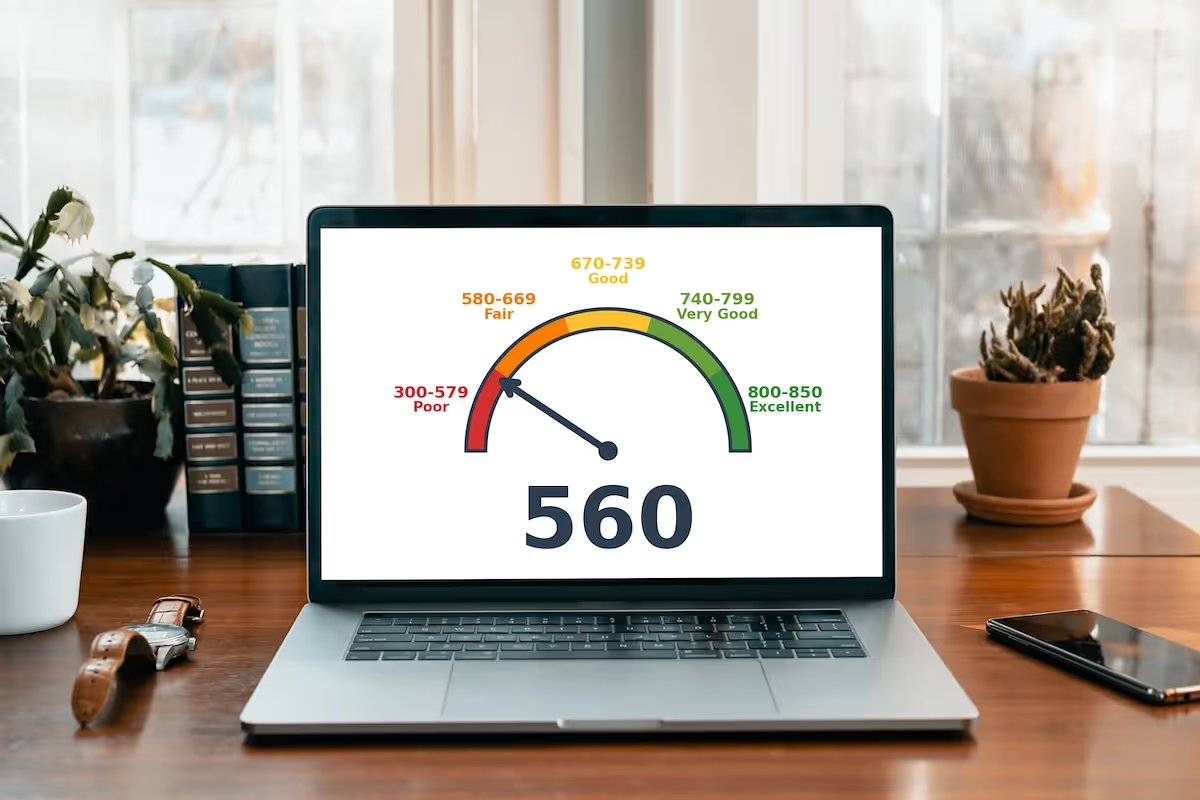
Kudos has partnered with CardRatings and Red Ventures for our coverage of credit card products. Kudos, CardRatings, and Red Ventures may receive a commission from card issuers. Kudos may receive commission from card issuers. Some of the card offers that appear on Kudos are from advertisers and may impact how and where card products appear on the site. Kudos tries to include as many card companies and offers as we are aware of, including offers from issuers that don't pay us, but we may not cover all card companies or all available card offers. You don't have to use our links, but we're grateful when you do!
560 Credit score: What You Need to Know in 2025
July 1, 2025


TL;DR
A 560 credit score is a foundational step on your credit journey, offering a clear path toward financial growth. According to the FICO model, this score falls into the "Poor" category, which simply means there are excellent opportunities to build a stronger credit profile.
What Does a 560 Credit Score Mean?
A 560 credit score falls into the "poor" category on the widely used FICO scale, which ranges from 300 to 850. Lenders often consider scores below 580 to be subprime, signaling a higher-risk borrower. This can directly impact your financial opportunities, as creditors may be more cautious about extending you new lines of credit, making it more difficult to get approved for loans or credit cards.
This score can translate to higher interest rates on any approved credit, making borrowing more expensive. You might also face challenges securing an apartment or setting up utilities without a significant security deposit. While a 560 score presents clear financial hurdles, understanding its meaning is the first step toward building a stronger credit profile for the future.
Who Has a 560 Credit Score?
While age isn't a direct factor in calculating your credit score, there is a strong correlation between age and creditworthiness. According to 2023 FICO data, average scores tend to increase steadily with each generation:
- Generation Z (ages 18-26): 680
- Millennials (ages 27-42): 690
- Generation X (ages 43-58): 709
- Baby Boomers (ages 59-77): 745
- Silent Generation (ages 78+): 760
Credit Cards With a 560 Credit Score
A credit score of 560 falls into the poor credit range, which can significantly impact your ability to qualify for most credit cards. Lenders generally view this score as high-risk, leading to likely rejections for traditional unsecured cards that offer premium rewards or low interest rates. Consequently, your options will probably be limited to secured credit cards that require a security deposit or specific unsecured cards for bad credit, which typically carry higher fees and interest rates.
Kudos can help you find the right card with its AI-powered Explore Tool, which personalizes recommendations based on your needs. The tool uses a quiz to understand your preferences, such as building credit or finding a low-interest card, and then matches you with suitable options from its database of nearly 3,000 cards.
Auto Loans and a 560 Credit Score
Having a 560 credit score places you in the subprime borrower category, which means you can expect to face significantly higher interest rates for an auto loan, according to a 2025 guide. Lenders view this score as a greater risk, which translates to less favorable loan terms and a higher overall cost of borrowing.
- Super-prime (781-850): 5.25% for new cars, 7.13% for used cars
- Prime (661-780): 6.87% for new cars, 9.36% for used cars
- Non-prime (601-660): 9.83% for new cars, 13.92% for used cars
- Subprime (501-600): 13.18% for new cars, 18.86% for used cars
- Deep subprime (300-500): 15.77% for new cars, 21.55% for used cars
Mortgages at a 560 Credit Score
A 560 credit score significantly narrows your mortgage options, but it doesn't completely close the door. Your most viable path is an FHA loan, which is designed for borrowers with lower credit scores. However, with a score below 580, you will need to provide a down payment of at least 10%. Other government-backed loans like VA or USDA are technically possible but unlikely, as most lenders require higher scores. Conventional loans are generally unavailable for scores under 620.
This credit score will also lead to less favorable loan terms. You can expect a higher interest rate, which increases the total cost of your loan over its lifetime. Beyond the larger down payment, FHA loans also come with additional mortgage insurance fees. Lenders will likely put your application through a more rigorous manual underwriting process to offset the perceived risk.
What's in a Credit Score?
Figuring out what goes into your credit score can feel like trying to solve a complex puzzle, but it generally boils down to a handful of key elements. The most common factors include:
- Your payment history, which tracks whether you pay your bills on time, is the most significant factor.
- Credit utilization, or the amount of credit you're using compared to your total available credit, also plays a major role.
- The length of your credit history demonstrates your experience with managing credit over time.
- Having a healthy mix of different types of credit, such as credit cards and installment loans, can positively impact your score.
- Finally, recent credit inquiries, which occur when you apply for new credit, are also taken into account.
How to Improve Your 560 Credit Score
Your credit score plays a crucial role in your financial life, but a low number isn't a life sentence. With consistent effort and the right strategy, it is always possible to improve your credit score over time.
- Set up automatic bill payments. Since payment history is the single biggest factor in your score, ensuring you never miss a payment is the most critical step to stop your score from falling and begin building a positive record.
- Apply for a secured credit card. These cards are designed for people rebuilding credit and require a small security deposit, but your on-time payments are reported to the credit bureaus to help build your history.
- Lower your credit utilization ratio. Aim to use less than 30% of your available credit, as this shows lenders you can manage debt responsibly and aren't overextended.
- Monitor your credit reports. You can get free reports from all three major bureaus to check for errors or inaccuracies that could be unfairly dragging down your score.
For more details on these strategies, an expert guide from Kudos can help you make smarter credit decisions to maximize your score.
Unlock your extra benefits when you become a Kudos member

Turn your online shopping into even more rewards

Join over 400,000 members simplifying their finances

Editorial Disclosure: Opinions expressed here are those of Kudos alone, not those of any bank, credit card issuer, hotel, airline, or other entity. This content has not been reviewed, approved or otherwise endorsed by any of the entities included within the post.



































.webp)


.webp)






